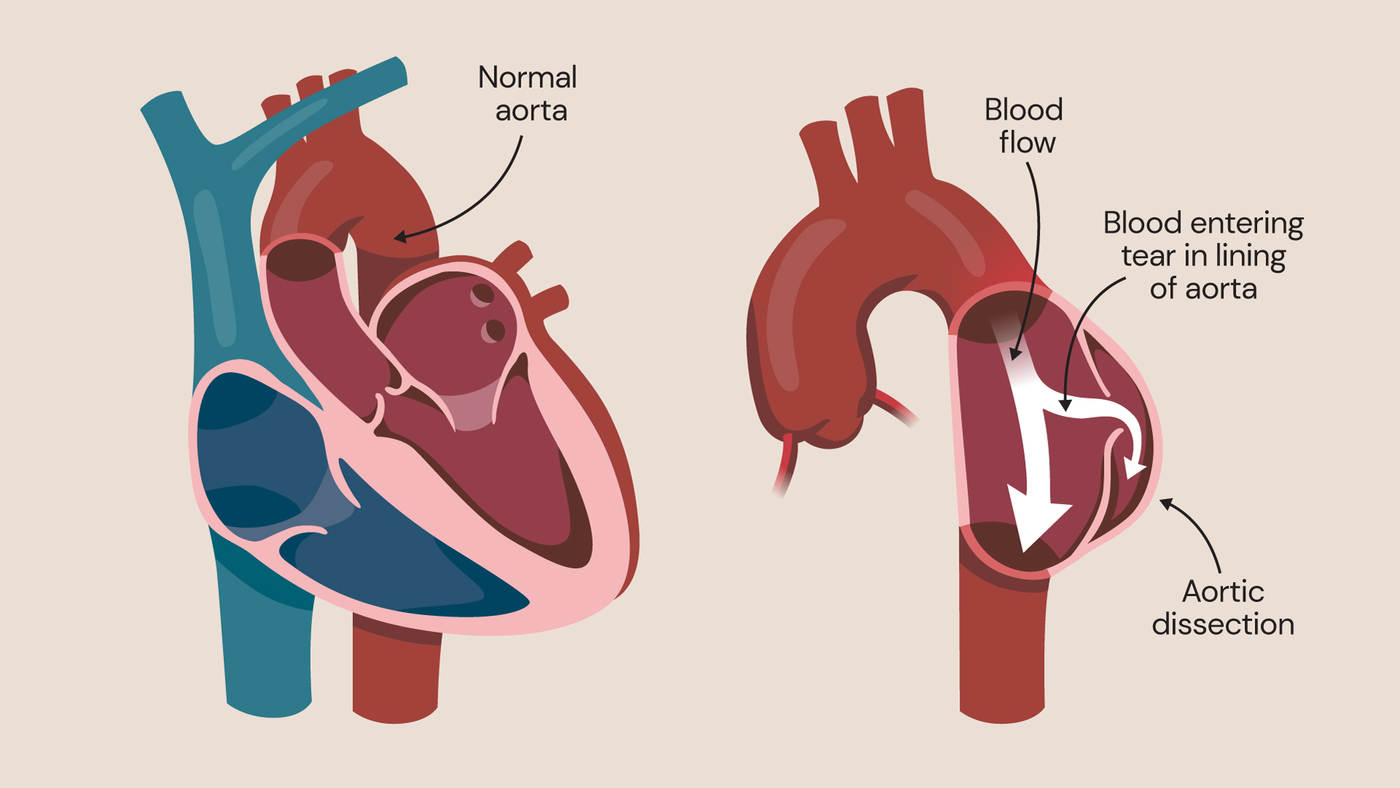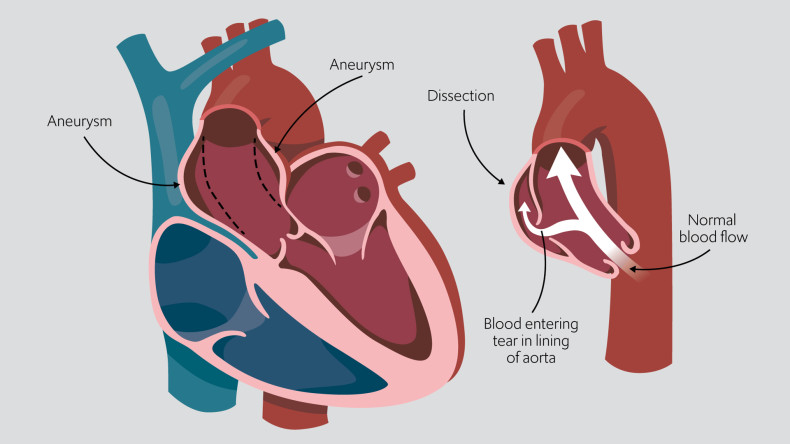Aortic dissection is a life-threatening condition caused by the separation of the layers in the aortic wall (the aorta is the major artery that carries blood from the heart to all parts of the body). In aortic dissection, the inner layer of the aortic wall tears and blood leaks between the layers.
A sudden aortic dissection has a very high mortality rate, with patients dying before reaching the hospital. However, early diagnosis, careful treatment and surgery, when necessary, can effectively treat aortic dissection and save lives.
What is aortic dissection?
“An aortic dissection is a serious condition in which there is a tear in the inner layer of the aorta – called the intimal layer. Blood leaks through the tear, splitting the inner and middle layers of the aorta; this split is known as dissection,” explains our consultant cardiologist Professor Christoph Nienaber.
Aortic dissection can happen suddenly or gradually over time:
- acute aortic dissection – the tear is sudden, and blood can rush through the layers. In acute aortic dissection, the bleeding can be severe and often deadly
- chronic aortic dissection – happens over more than two weeks. There is a slower blood leak, and the mortality rate is lower

What causes aortic dissection?
Aortic dissection is more likely to happen if the wall of the aorta is weakened and vulnerable to tears. Occasionally, people are born with conditions that make the blood vessel walls fragile, but some acquired chronic conditions such as hypertension (high blood pressure) can damage the aortic walls as well. Known risk factors for aortic dissection include:
- aortic aneurysm
- hypertension
- sudden, severe increase in blood pressure due to weightlifting, recreational drugs, use of cocaine or energy drinks
- furring of the blood vessels due to atherosclerosis (build up of fats, cholesterol and other substances in and on the aorta walls)
- pregnancy and childbirth particularly in people with connective tissue problems like Marfan’s syndrome
- family history of aortic dissection
- genetic conditions, including Marfan syndrome, Loeys-Dietz syndrome, vascular Ehlers-Danlos syndrome, Turner syndrome, and bicuspid aortic valve condition
- previous surgery to the aorta can damage the aortic wall
- conditions that cause vasculitis (inflammation or infection of the blood vessels); these may include syphilis and cocaine usage
What is an aortic aneurysm?
“An aortic aneurysm is an abnormal swelling or bulging in the aorta, the large blood vessel that carries blood from the heart down through the chest and abdomen. An aortic aneurysm can develop if the walls of the aorta get weaker and expand outwards,” explains Professor Nienaber.
Aneurysms are described according to their position on the aorta: Abdominal aortic aneurysms (AAA) are in the abdomen, thoracic aortic aneurysms (TAA) are in the chest. If you have an aortic aneurysm, you are more likely to develop aortic dissection.

Aortic dissection symptoms
You will suddenly feel severely unwell with associated chest and/or back pain if you have an acute aortic dissection. Call 999 immediately; aortic dissection is an emergency that needs urgent treatment. Look out for:
- sudden, severe ripping pain in your chest, back or between your shoulder blades
- the location of the pain depends on the position of the dissection; you may feel it in your jaw, face, neck, chest, tummy or lower limbs
- feeling cold and clammy
- fainting and collapse
- a feeling of panic and impending doom
- stroke symptoms include weakness or numbness on one side of the body
- confusion and drowsiness
- numbness, tingling or weakness in the limbs
Aortic dissection types
Aortic dissection is classified according to the location along the aorta. There are two types of aortic dissection: Type A and Type B. The management, treatment and risk of complications are different for each type.
Type A aortic dissection is located in the upper parts of the aorta near the heart, the ascending aorta and the aortic arch. Type A dissection usually needs surgery to repair the aorta and sometimes aortic valve replacement because the risk of rupture is high. Type A is twice as common as Type B dissections.
Type B aortic dissection is located in the thoracic aorta, but in the descending segments of the aorta. Type B dissection rarely need open surgery. The risk of rupture is lower, and your doctor may be able to manage your condition by controlling your blood pressure with medication at least initially; in addition to medication keyhole intervention using endovascular stent-grafts may be indicated after careful imaging follow-up.
Aortic dissection treatment
“Swift diagnosis and prompt, effective treatment are vital in managing aortic dissection. An acute dissection in the ascending aorta is a surgical emergency; you will need intensive specialist medical support to replace lost fluids, monitor major organs and stabilise you for non-delayed surgery,” explains Professor Nienaber.
“The treatment of aortic dissection depends on the type of disease. If you have a Type A dissection, you are likely to need emergency surgery; a Type B dissection may be managed with medication and monitoring.”
Medical management of aortic dissection
If your type B dissection is chronic and stable, medical management is the best treatment option.
Treatment aims to reduce the strain on your aorta. This is achieved by treating pain, supporting your body systems, decreasing your blood pressure and the force exerted when your heart beats. Your specialist team will monitor you and give you antihypertensive drugs, including beta-blockers, to lower your blood pressure to normal levels.
Surgery for aortic dissection
If you need surgery, your cardio-thoracic surgeon or aortic specialist will choose the best way to repair or replace the damaged part of the aorta, considering the severity of the dissection, its location, your general health and the risk of surgical complications.
Therapeutic options include:
- open surgical excision or repair of the dissected area of the aorta, fixing the area where blood can leak, and insertion of a synthetic vascular graft to reinforce the blood vessel
- endovascular stent-grafting (TEVAR): Grafting a stent from the inside of the aorta is a less invasive alternative to surgery. It is most frequently used for Type B dissections
- replacement of part of the aorta (sometimes with aortic valve replacement): If the dissection involves the ascending aorta, your surgeon will replace the aorta with a synthetic graft. They will also assess the aortic valve for damage; if affected, they will either resuspend or excise the valve and replace it with a prosthetic device
Raised blood pressure stresses the blood vessels. If you have an aortic dissection, even if you have had surgery to repair or replace part of the aorta, you will need to take drugs to control your blood pressure for the rest of your life.
Contact us
For more information or to book an appointment, please contact our customer care team.
